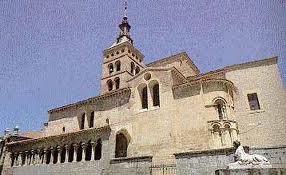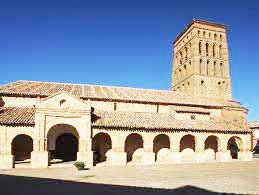Late Romanesque Architecture
The development of Romanesque architecture in Spain was closely connected to the increasing popularity of the pilgrimage to Santiago de Compostela and the rapid expansion of the Cluniac Order through the peninsula. Consequently, from the first half of the XI century onwards a new architectural style emerged, which was very much determined by the religious service it was meant to provide.
The defining characteristics of Romanesque architecture are found in religious buildings, which are supposed to exude the fundamental principles upheld by the clergy of the time, almost as an allegory, whereby the Church could be recognised as a unified and ubiquitous presence, solid and massive, impenetrable from the outside but warm and welcoming on the inside, self-contained, symmetrical, measured, beautiful... in short, both imposing and inviting at the same time.

During the apogee of the Romanesque style, from mid-XI century to the end of the XII century, the architecture that spread across the landscape of much of modern-day Italy, France, Germany and Spain became progressively bolder and more self-assured, acquiring a monumental dimension that, somehow, mirrored the obscene enrichment enjoyed by the religious institutions of the time, primarily the Vatican and the Order of Cluny.
As the original intentions that led to the Cluniac reform at the end of the X century got polluted in practice, Romanesque architecture also underwent its very own, and likely totally independent, process of contamination, or development. Thus, towards the end of the XII century Romanesque buildings in Spain acquire a substantially different look. A classic example of the progression from Romanesque to Late Romanesque architecture can be found in the Church of St Martin of Segovia.
Itself a blend of styles, the Church of St Martin in Segovia still today boasts a large and impressive arcade with traditional semicircular arches held by double columns and decorated capitals. However, a first glance at the gate that leads towards the arcade displays an unfamiliar shape, as the semicircular arch has been adulterated by three overlapping semicircles that give the portal a three-foiled pattern.
These modifications in the specific case of Romanesque architecture in Spain can often be traced to a Muslim influence, which in turn led to Mozarabic and Mudéjar styles. Evidently, the coexistence of Christian and Muslim societies in the peninsula through the best part of eight centuries, at least half of which were years of intense conflict, produced a substantial cultural exchange.
Mozarabic and Mudéjar Architecture
The term Mozarabic is used to refer to the Christian population who lived under Muslim dominance at diverse moments during this period. While ostensibly still Christian, the prevalence of Arabic elements in the architecture of the period is evident. And, while few examples of the style remain intact, several common artistic features stem from this blend, such as the propagation of the alfiz (an arch that is almost fully circular surrounded by a square ornament), or the horseshoe arch.

The Mudéjar, on the other hand, were the cultural opposites to Mozarabs, in that they were unconverted Muslims left behind in the Christian kingdoms. The mark they left in the characteristics of Romanesque architecture in Spain was significant, primarily through the use of brick in constructions, such as the churches of St Tirso and St Lorenzo in Sahagún.
As a matter of fact, were you to enroll on a Spanish course in Seville, you would be faced with one of the most significant samples of Mudéjar architecture, in the Alcázar of the city.
Another remarkable example of the combination of styles and techniques used towards the end of the XII century is found on the small church of the Holy Sepulchre in Torres del Río. Almost a chapel in size, it was built by the Knights Templar using an array of techniques, that give it a secular air from the outside. Nevertheless, inside the intricate pattern in the erection of its polygonal cupola is simply staggering and evidences Mudéjar influences.
By the end of the XII century the unity and uniformity of Romanesque architecture in Spain has already been disrupted. A new crisis loomed large over the clerical establishment and the transition towards a new style waited just around the corner.
